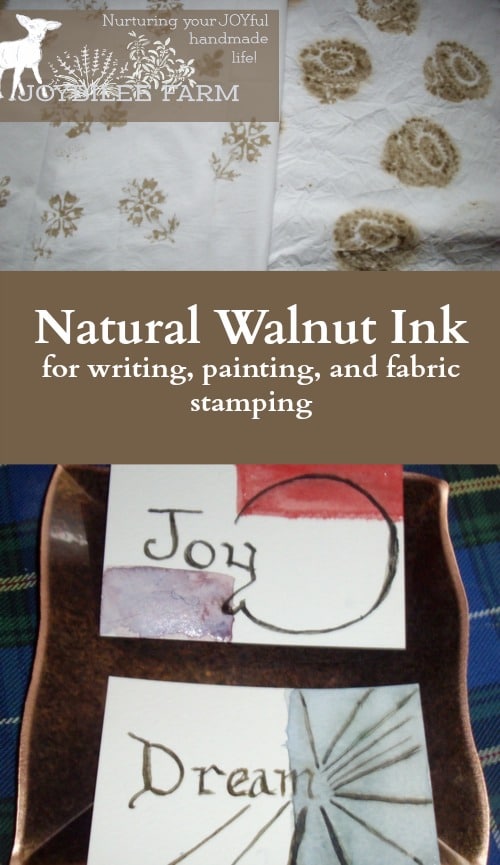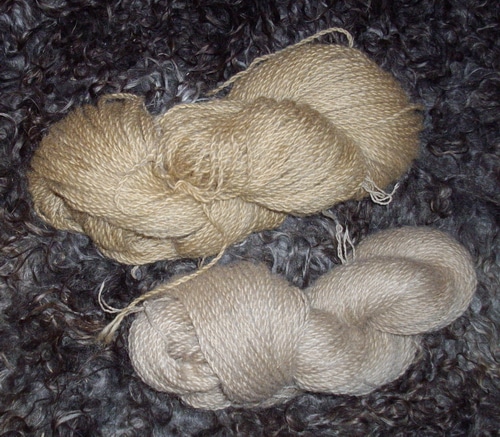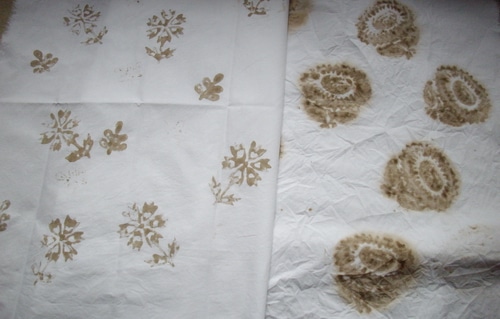Natural dye ink for fabric stamping
First, if you are allergic to walnuts, don’t try this. The nut proteins are released in the air during the simmering process. Oak galls can also be used for ink and in fact are the traditional black ink for scribes and calligraphers. Oak galls are not readily available in BC’s mountains but I can get walnut hulls. And so for the rest of us….

Walnuts are rich in both natural dye chromophores and tannins. Both English and Black Walnuts can be used for dyeing. So can other nuts in this family like butternuts and heartnuts, with slightly different shades of brown. All are rich in tannins and natural dye.
You use the green hulls that encase the nuts on the tree for the richest source of dye. Leaves, twigs, and walnut shells can also be used for natural dyeing but the richest browns come from dye baths made from the hulls. You want the hulls to oxidize to black before you use them. I achieve this by gathering them in the fall, putting them in a plastic bag on the deck, in a covered bucket, and letting them go through the freeze/thaw process of fall. In January, when I have more time, I utilize them for dyeing.
Make sure you are only using the hulls and that there are no nuts left in the bag or you may have to fight the squirrels for them.
Walnut is a stain and it can be used for ink as well as dye. The difference is the concentration of the finished product.
To make the dye, cover walnut hulls in water in a large stock pot, reserved for dyeing. Simmer the hulls for 4 to 6 hours on low to concentrate the dye. Strain it through a strainer to remove the hulls and the walnut slime. You don’t want it on your fiber. It makes the dye uneven and is hard to wash completely off. You can use unmordanted fiber, but the dye will not be as fast, although still acceptable. I like to mordant wool with alum and cream of tartar before dyeing with walnuts. Since walnuts are rich in tannins you don’t need to add additional tannin to the mordanting bath of cotton, but you can.
You can add an iron rail spike or other old iron pieces, or even dye in an iron caldron to deepen the colour of your dye bath. Some people report getting a rich black from walnuts and extra tannin but I have only been able to achieve darker browns.
4 years ago I dyed yarn with walnut and knit Robin a sweater. He still wears the sweater and although the colour has lightened somewhat with washing and wear, it is still a lovely shade of golden brown.

From Dye Bath to Walnut Ink
To use the walnut dye bath for ink you will want to concentrate it. Pour a portion of the strained and filtered walnut dye liquor through a fine seive to remove any large chunks of walnut hull remaining. Put into a stainless steel pot, add a rail spike for dark brown – to black ink, or leave as is for a warm brown ink. Simmer without boiling on the back of a woodstove or on low heat until you have reduced the liquid by half.
Strain the resulting concentrated liquid through a finely woven cotton cloth. I used a piece of tea towel, cut from a towel that had worn too much to use. Line your seive with the cloth and pour your hot bath through the cloth to strain out the walnut hull scum. Allow it to drip through naturally without squeezing. Transfer it to a wide mouth canning jar(s).
To use for ink for a fountain pen or calligraphy pen, Add 1 tbsp. 99% isopropyl alcohol per 1 litre of strained, concentrated walnut dye, as a preservative. The consistency is perfect for writing with a fountain pen. The concentrated dye, that has been simmered with iron, gives a dark brown, almost black colour on off white water colour paper. Without the iron, the ink is a warm, deep brown.
The ink is permanent on water colour paper, once it has dried. You can do a water colour wash over it and it will not bleed.
You can also use the reduced walnut dye as a stamp pad ink by adding glycerine to the prepared ink — 2 tbsp of glycerine, to 2 tbsp. prepared ink (already has the alcohol added). Test it for concentration before you commit it to your stamp pad. You may want to concentrate the dye bath by reducing it to 1/3rd before mixing glycerine and alcohol with it. Brush onto a stamp pad or sponge to use for stamping on paper.
From Dye bath to Fabric Printing
You can also use your concentrated walnut dye for fabric printing using block stamps or other stamps. The walnut ink is too liquid to leave an impression without dripping and bleeding. The ink must be thickened. Traditionally this is done by adding a gum, such as gum arabic or gum tragacanth. Gum Arabic is used for paper crafts and is the medium typically used in water colour paints as a thickener. Gum tragacanth has more sugar and is normally used in cake decorating and candy making. Either can be used to thicken.
You can also use walnut natural dyes for immersion dyeing — to dye both yarns and fabric.

Instructions for making fabric paint:
Get your walnut hulls and proceed as you would to make a dye bath. Strain out the dye and concentrate it by half on your stove. Add a piece of iron or simmer it in a cast iron pot if you want to make the colour a dark chocolate brown rather than a reddish, golden brown, without the iron adjunct. Or do like I do and make two batches, one with iron and one without.
Strain the concentrated dye to get out any walnut slime or bits of hull that you missed. Be careful at this point. The walnut dye will stain anything it comes in contact with and it is really easy to tip your vessel as you are trying to strain it. I do it in the sink and have more than once tipped the vessel and spilled my precious liquid down the drain. Learn from my mistakes and make sure that the bottom vessel that is receiving your precious dye from the straining apparatus is secure from spills.

Then you will need some gum arabic or gum tragacanth as a thickener, to give the dye/ink the right flow properties. The gum also give the dye a medium to help it adhere to the cloth or paper while it is drying. You will need to experiment to get exactly the right proportions. Add 5% alcohol (I use 98% isopropyl alcohol) to the mix. This increases the drying speed of the ink and will help to preserve the ink.
Recipe for Walnut Ink for fabric stamping
2 cups prepared concentrated dye liquid, heated
1/4 to 1/2 tsp. gum tragacanth
1 tbsp. 99% Isopropyl alcohol
The amount of gum that you need will depend on how thick you got the dye liquid when you reduced it. So add the gum just 1/4 tsp at a time and blend it and wait 10 minutes to check the consistency before adding more gum to the batch.
Blend the dye liquid with the gum in a blender until the whole mixture is smooth and takes on a glassy appearance. Add the alcohol and blend until smooth. Put in a jar and allow to cool. You can thin it with water if it is too thick. Or add more gum tragacanth if it seems to thin. But add the gum a mere 1/4 tsp. at a time and give it a chance to set up before adding more. Otherwise it will jell too fast on cooling and you will have a lot of water to add before it is the right consistency again. This water will dilute the colour. This recipe makes 2 concentrated cups of dye for stamping, print making or painting on fabric. You can thin it with water if necessary to make it a good consistency for use but it will lighten the colour. Better to get it right with the dye liquid when you begin.
Test your finished dye and see if it will flow for drawing or writing on fabric or paper or if its the right consistency for stamping. Add more gum a bit at a time to make it thicker, or add more alcohol to make it more fluid.
When using it as a fabric paint or a stamping medium, you will need to batch the fabric for 7 days and then steam set it before washing. Although it is permanent as soon as it is dry, you will get better colourfastness if you batch. Once set, you can then add other effects by dipping in other weak dye baths to give back ground colours.
Utilizing the walnut dye as fabric paint
This is a great technique for layering colour and motifs, stitching embellishments and multimedia fabric art. Prepare your fabric for dyeing by washing well in water to which washing soda has been added to strip the fabric of sizing, starches, and coatings. Rinse well.
Stamping on damp fabric will allow the edges of the design to bleed and soften. The design adheres well to the fabric. After drying and batching, it should be permanent.
Stamping on dry fabric gives a very sharp design that dries to a rich chocolate brown. This also needs to be batched before washing to allow for maximum light fastness.
Once the stamped motifs have aged you can safely wash the fabric and over dye it in another colour. Consider a myrobolen over dye. Myrobolen is a yellow dye that is rich in tannin and will make the walnut/iron dye darken with age.

Using walnut ink as a nontoxic wood stain
And if all this local, natural pigment turned into ink, stamping ink or fabric paint wasn’t enough to make you start looking for walnut trees in your neighborhood, you can also use the concentrated ink as a wood stain. Just take the concentrated dye, with or without thickener and alcohol and, while wearing gloves, rub it with a dry cloth onto your wood surface. Nontoxic and rich. It is water based so it will life the grain slightly. You can give it a fine sanding once it dries to even out the surface.
Other posts you may be interested:
Natural Walnut Dye for stamp pads and fountain pens


